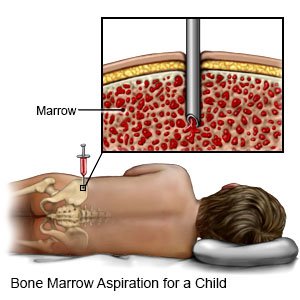Pancytopenia in Children
Medically reviewed by Drugs.com. Last updated on Aug 4, 2025.
Your child is at risk for infection and bleeding. There are several things you can do to help prevent infection and bleeding. Your child may also feel very tired. Help balance your child's activity with rest to prevent extreme tiredness.
WHILE YOU ARE HERE:
Informed consent
is a legal document that explains the tests, treatments, or procedures that your child may need. Informed consent means you understand what will be done and can make decisions about what you want. You give your permission when you sign the consent form. You can have someone sign this form for you if you are not able to sign it. You have the right to understand your child's medical care in words you know. Before you sign the consent form, understand the risks and benefits of what will be done to your child. Make sure all of your questions are answered.
Stay with your child for comfort and support
as often as possible while he or she is in the hospital. Ask another family member or someone close to the family to stay with your child when you cannot be there. Bring items from home that will comfort your child, such as a favorite blanket or toy.
Your child may need extra oxygen
if his or her blood oxygen level is lower than it should be. Oxygen may be given through a mask or through small tubes placed in your child's nostrils. Ask a healthcare provider before you take off the mask or tubing.
Neutropenic precautions:
Your child may be placed in a single room until his or her white blood cell levels are higher. This protects your child from other people who may have infections. Your child's healthcare providers will instruct all visitors to wash their hands before and after visiting your child. Ask your child's healthcare provider for more information about neutropenic precautions.
Monitoring:
Your child's heart rate, heart rhythm, blood pressure, and breathing will be monitored closely.
Medicines:
Medicines may be given to treat the cause of pancytopenia.
Tests:
- Blood tests are used to check for infection and blood cell levels. Blood tests may also show your child's iron, folate, and vitamin B12 levels. The protein that helps your child's body make red blood cells may also be checked.
- Urine tests check for infection and kidney function.
- A bone marrow biopsy is a procedure to remove a small sample of bone marrow from your child's bone. This procedure is used to check how well your child's bone marrow is making blood cells. The bone marrow sample is also checked for tumors or anything that prevents the bone marrow from making healthy cells.

Treatment:
- A blood transfusion can help increase red blood cell, white blood cell, and platelet levels. This may prevent bleeding or organ damage. This does not treat pancytopenia. Instead, a blood transfusion may keep your child safe until the cause of pancytopenia is known.
- A stem cell transplant is a procedure to replace unhealthy stem cells with healthy cells. Stem cells are able to become all of the blood cells. Stem cells can also travel to your child's bone marrow and can become new bone marrow cells.
RISKS:
Pancytopenia can cause life-threatening heart failure, infection, and bleeding.
CARE AGREEMENT:
You have the right to help plan your child's care. Learn about your child's health condition and how it may be treated. Discuss treatment options with your child's healthcare providers to decide what care you want for your child.© Copyright Merative 2025 Information is for End User's use only and may not be sold, redistributed or otherwise used for commercial purposes.
The above information is an educational aid only. It is not intended as medical advice for individual conditions or treatments. Talk to your doctor, nurse or pharmacist before following any medical regimen to see if it is safe and effective for you.
Learn more about Pancytopenia
Treatment options
Care guides
Further information
Always consult your healthcare provider to ensure the information displayed on this page applies to your personal circumstances.
